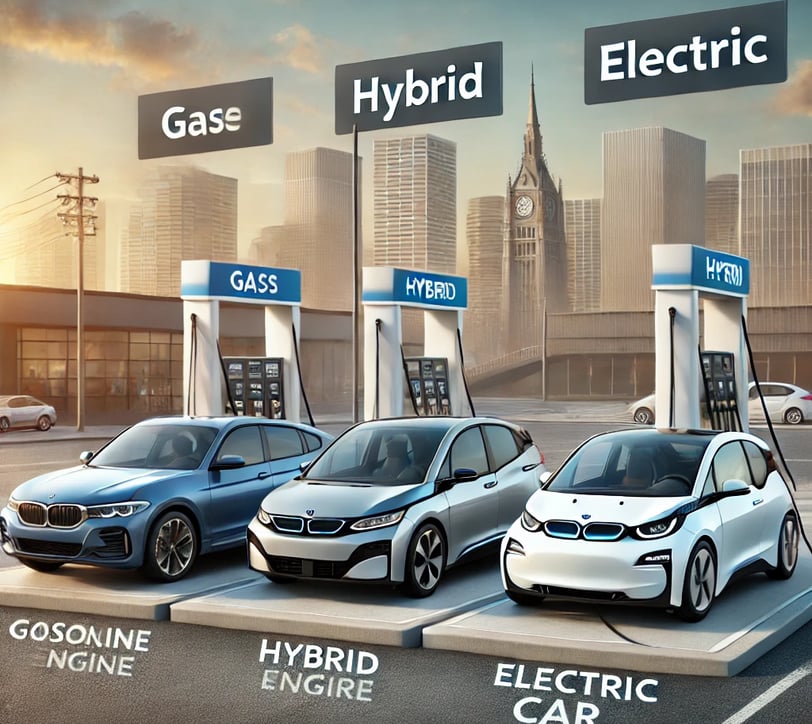Evaluating Gas, Hybrid, and Fully Electric Cars: A U.S. Perspective
The automotive industry is undergoing a significant transformation, providing American consumers with an expanding array of vehicle choices. Among the most debated options are traditional internal combustion engine (ICE) vehicles, hybrid cars, and fully electric vehicles (EVs). Each of these categories has unique benefits and drawbacks, influencing consumer decisions based on cost, practicality, performance, and environmental considerations.
2/14/20253 min read


This article presents a thorough comparison of these three vehicle types, discussing their advantages and disadvantages while highlighting some of the most popular models available in each segment.
1. Gas-Powered Vehicles (Internal Combustion Engine - ICE)
Advantages:
Widespread Refueling Infrastructure: The U.S. has a well-established network of gas stations, making refueling quick and easy.
Lower Initial Purchase Price: Gasoline vehicles tend to have a more affordable upfront cost than hybrids or EVs.
Extended Driving Range: A full tank can enable travel of 400-500 miles without needing to refuel.
Familiar Servicing and Repairs: Most mechanics are well-equipped to handle ICE vehicle maintenance and repairs.
Disadvantages:
Fluctuating Fuel Prices: Gasoline prices are subject to frequent changes based on global market conditions.
Environmental Concerns: ICE vehicles emit pollutants contributing to air pollution and climate change.
Higher Maintenance Costs: Regular servicing, including oil changes and transmission upkeep, is necessary.
Regulatory Risks & Depreciation: With stricter emission regulations emerging, resale values may decline over time.
Popular Models in the U.S.:
Toyota Camry – A reliable and fuel-efficient mid-size sedan.
Ford F-150 – America’s best-selling vehicle, known for its power and versatility.
Honda Civic – A long-standing favorite for affordability and reliability.
2. Hybrid Vehicles (HEV & PHEV)
Advantages:
Better Fuel Economy: Hybrid technology reduces fuel consumption, leading to savings at the pump.
Lower Emissions: While not completely emissions-free, hybrids produce fewer pollutants than gas-powered cars.
Potential Tax Incentives: Some plug-in hybrid electric vehicles (PHEVs) qualify for government tax benefits.
Versatile Powertrain: PHEVs allow short electric-only trips while still offering gasoline power for longer journeys.
Disadvantages:
Higher Purchase Cost: Hybrids tend to cost more than traditional gasoline cars due to dual powertrains.
More Complex Maintenance: Additional components like battery packs and electric motors can add to maintenance expenses.
Limited Electric Range (PHEVs): Most plug-in hybrids have a modest battery range (10-50 miles) before switching to gasoline.
Popular Hybrid Models in the U.S.:
Toyota Prius – A pioneering hybrid known for outstanding fuel efficiency.
Honda CR-V Hybrid – A practical SUV offering strong mileage.
Ford Escape PHEV – A plug-in hybrid with an electric range of up to 37 miles.
3. Fully Electric Vehicles (EVs)
Advantages:
Zero Tailpipe Emissions: EVs contribute to cleaner air by producing no direct pollution.
Lower Operational Expenses: Electricity is usually cheaper than gasoline, and EVs require less maintenance.
Smooth & Quiet Driving Experience: Instant torque and silent operation enhance driving comfort.
Government Incentives: Federal tax credits up to $7,500 (varies by model) and state incentives help reduce costs.
Disadvantages:
Charging Availability: While improving, charging infrastructure is still inconsistent across different regions.
Higher Upfront Price: EVs often come with a higher initial cost, though prices are gradually declining.
Range Concerns: Some drivers worry about running out of charge on long trips, despite range improvements.
Battery Longevity: Over time, batteries lose efficiency, though manufacturers provide long-term warranties.
Popular Electric Models in the U.S.:
Tesla Model 3 – A top-selling EV with an excellent balance of range and performance.
Ford Mustang Mach-E – A sleek electric SUV with strong capabilities.
Chevrolet Bolt EV – A budget-friendly electric hatchback offering competitive mileage.
Conclusion
Each type of vehicle—gasoline, hybrid, and electric—comes with its own advantages and drawbacks, affecting buyers' decisions based on personal preferences, financial considerations, and environmental priorities. While gasoline cars offer convenience and familiarity, hybrids serve as an efficient transition toward sustainability, and EVs provide the most environmentally friendly and cost-effective long-term solution.
As charging networks expand and battery technology advances, electric vehicles are becoming a more practical choice. However, hybrids remain an appealing alternative for those not ready to fully transition, and traditional gas-powered cars continue to be a strong option for those valuing affordability and long-range travel.
Selecting the right vehicle requires an assessment of driving habits, costs, and long-term benefits. No matter the choice, the U.S. automotive industry is evolving rapidly, offering more options than ever before.
Explore
Discover diverse topics in one convenient hub.
Connect
Learn
contact@mindstormblog.com
© 2025. All rights reserved.


